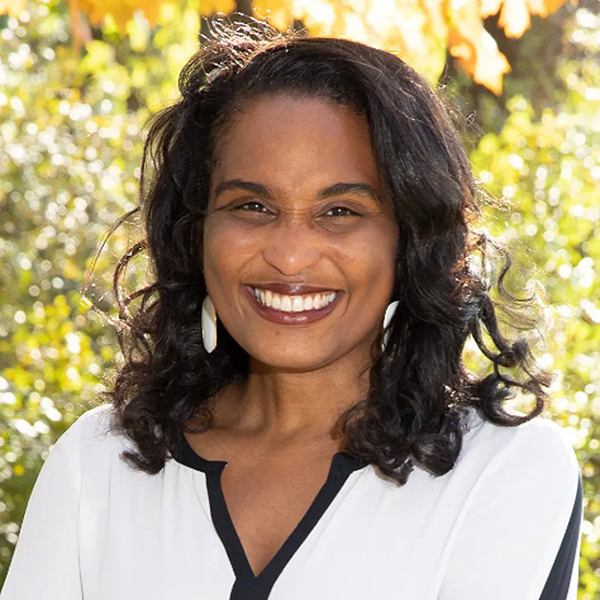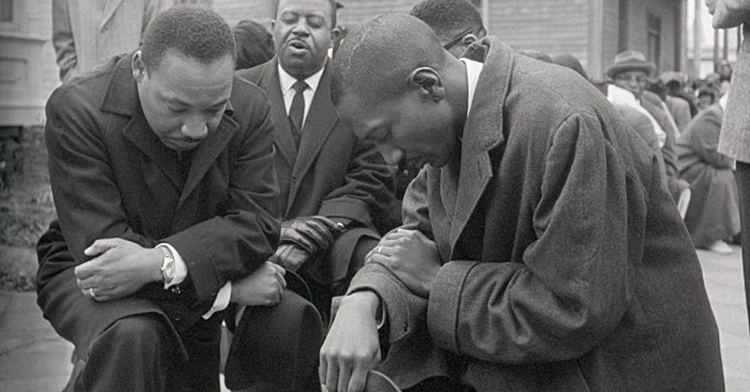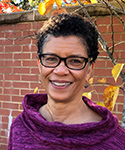Any institution that wants to be engaged in reconciliation must view it as a gospel truth that becomes a part of their organizational DNA, says Alvin Sanders, director of EFCA Samaritan Way, the reconciliation ministry of the Evangelical Free Church of America. Building reconciliation into the policies and practices of a church, a school or a business requires sacrifice. The commitment to serve as part of diverse communities depends on philosophical and theological underpinnings that guide leaders to “pick the battles that Jesus would pick.”
Before being named the executive director of reconciliation for the EFCA, Sanders served for many years as an urban minister in Chicago and Cincinnati. He was the founding pastor of River of Life Church in Cincinnati and director of ethnic ministries for Cincinnati Christian University. He is the author of “Reconciliation 101: A Handbook for Ministry Leaders.”
While at Duke Divinity School’s Summer Institute, Sanders spoke with Faith & Leadership about the nature of reconciliation and the role of Christian institutions in bringing it about. The video clip is an excerpt of the following edited transcript.
Q: How did River of Life Church in Cincinnati begin?
A man named Jonathan Burnham, who was the senior pastor of Hope Evangelical Free Church in Mason, Ohio, had a vision to start churches in hard-to-reach places. They started churches around the world, and their motto was to find a leader who they believed God called to minister in that particular demographic context and then resource that leader. So they hired me to do that. Hope Church is a suburban, white, upper-middle-class church, and we wanted to plant a church in downtown Cincinnati in a community called Over-the-Rhine. Over-the-Rhine traditionally was an African-American community and mainly poor people lived there, but there also were an eclectic mix of the creative class. Eventually, Jonathan and I built a relationship, and out of that birthed a vision to do a church plant.
Q: What are some of the key things that you teach about reconciliation?
“Reconciliation 101” is a handbook that I wrote for Evangelical Free Church pastors. I had a vision -- like how you have a handbook in your car: you have the car and the handbook that sort of guides you and teaches you how to drive the car, when to change the oil, those types of things -- that was the vision behind “Reconciliation 101.”
There are three very basic principles that I share.
Number one was reuniting the family. I believe that unless your reconciliation efforts emanate from the Scriptures, emanate from Matthew 22:37-40 -- love God with all your heart and soul and mind; love your neighbor as yourself, the Good Samaritan story -- unless you have a practical theological base, then you’re probably not going to be successful. So I call that reuniting the family.
The second principle is renewing the conversation. The reconciliation conversation has moved from a black-white polarizing dynamic to general cross-cultural, in-and-out principles. The immigration issue is part of the reconciliation conversation. The gender issue is part of the reconciliation conversation. The poverty issue is part of the reconciliation conversation. It’s more than just black-white racial dynamics. The church, when we’re talking about reconciliation -- if you’re just talking black-white racial dynamics, you’re 20 years behind the times. I’m trying to bring people up to speed as to the post–civil rights globalized conversation.
The third principle has to do with a practical model where you reframe the community that you’re leading. The reframing comes from Acts 6:1-7, which is a multicultural model where people are telling the truth about where they’re really at, because in our church situations, that’s sort of a lost art.
Reframing community has to do with truth telling along cultural lines. It has to do with developing interdependent partnerships across cultural lines. It has to do with providing dignity for all the people who are involved when it comes to the cross-cultural ministry, and it is a long-term journey. You never arrive. That’s the broad framework that “Reconciliation 101” lays out, and I try to help churches practically live that out.
Q: Your leadership position has changed from building a specific congregation to serving an entire denomination with reconciliation work. What is it like to go from serving on the front lines in congregations to stepping back and teaching others how to serve better?
I’m a big sports fan, and it’s like going from being an assistant coach to being the head coach, when you’re the coach of coaches. So pastors who are going down this road or want to engage this role, my role is to coach them, to encourage them, to help them develop the skills so that they can see fruit in their congregations. You go from leading on ground level to the 30,000-foot level, where you can see the whole big picture. So you go from influencing just a few hundred people to potentially influencing thousands of people.
Q: Do you ever feel distant from what’s happening in the places where people are worshipping?
When a pastor comes to me and he’s at square one and he doesn’t know anything about anything, I work with him for a year, and then you see some fruit. You have to rejoice in the fact that I served that pastor well, that God’s using me to produce fruit in his congregation even though from a distance.
It’s really a humbling experience, because you succeed when somebody else succeeds. You have to mature in your faith and say, “You know what? I’ve got to count other people’s success as my success.” I don’t want to downplay it. It’s been a two-year journey, but I think it’s been truly rewarding for me, to be able to humble myself and say, “Wow, God used me in that different context.”
Q: How has your academic work in educational administration been informed by your focus on reconciliation?
Any organization, whether it’s a church or whether it’s an educational institution, whether it’s a denomination, the whole key is that entity has to take reconciliation as a gospel truth that they want to work within the DNA of what they do. And so it starts from a philosophical perspective of “This is who we are as an institution,” and as they do that, then what happens is that philosophy begins to reflect itself in things like the mission statement, the vision statement, the policies, the practices, the procedures, the things that they decide to resource. It all flows from that philosophy that they have that this is part of the DNA of our institution.
The thing that we’re working with, with most Christian institutions, is they were not created with diversity or reconciliation in mind, so a lot of transformative leadership has to happen where people have to unlearn things and relearn things in order to be able to move the school down the road of reconciliation. So that’s really -- Jim Collins has a phrase in his book “Good to Great”: he says, “First who, then what.” So, at the institutional level, you have to start with the people that develop the institution and say, “Are these people on board with reconciliation?” That’s the bottom-line question. And if you have enough of those people on board in key leverage positions, then you can start to build some critical mass for doing the policies, the practices and the procedures that you need to do in order to signal to the world outside of the institution that we are a reconciled place.
Q: Bill Turner has taught theology at Duke Divinity School for 25 years. He was struck by how much change is still needed in our diversity ethos, and yet it’s possible.
Absolutely. Our denomination, Evangelical Free Church of America, was a Scandinavian denomination. They broke away from the state church, and those immigrants came over to the United States, and their denomination began to plant churches amongst Swedish and Norwegian immigrants. At some point, it dawned on somebody that we should be reaching outside of our ethnic enclave. Now they’ve essentially hired me. If I worked for a secular organization, I’d be considered a chief diversity officer. They’ve hired somebody to spearhead and lead the effort. Our mission statement is to glorify God by multiplying healthy churches among all people, and they’ve hired somebody to be the chief architect of the “all people” part. That’s a tremendous move from their ethos of where they were back in the ’40s and ’50s to where they’re at now.
Q: Why is it important that your reconciliation work is done within the context of the Christian church?
Reconciliation is God’s idea. It’s a gift from God to bring reconciliation to people. If that’s not your overarching vision, then what’s going to happen is you’re going to evolve downward, I believe, to the world’s definition of diversity, which is tolerating one another: “I can tolerate you if you give me a big enough paycheck,” or “I can tolerate you if you pass a law that says I have to tolerate you.” But God calls us to something much deeper than tolerating people, and that is to love one another.
First Corinthians 13 has to be that solid foundation of what it’s all about, which is that we would love one another. It talks about how we will know we are Christians by our love. And it has to be -- I cannot stress enough -- it has to be gospel-based. It has to be gospel-based. It has to be the driving force, because the lament and the pain and the anguish and the changes and the sacrifices that have to be made for the institution to move down the road -- there are going to be many times that the only reason they’re done is because the person feels a call from the Scriptures to do that. If they don’t have the call, there will be too much that they’ll lose, and they have to be willing to sacrifice, and lose things, in order to fulfill the call. And if they don’t have that sense of anointing, that sense of call, it won’t be enough to do it.
Q: Beyond the institutions you have been and are involved with, are there other places doing the kind of work you hope to encourage?
It’s like a cloud that is getting ready to release a storm and gathering slowly, and slowly, and you’re seeing little stories of hope around our denomination. I’ll just tell one very quickly. Steve Goold pastors a pretty large church in the Minneapolis area, and he was doing the typical upper-middle-class suburban thing, and he felt a lead from the Lord to take his church down the road of being externally focused.
There’s a book out that talks about being the best church for the community instead of being the best church in the community. It’s called “The Externally Focused Quest.” When he began to look at his community, he saw that his school system had many different ethnicities. Many Latinos were moving into the community; there were some poverty pockets developing. There were things that were happening that didn’t necessarily fit his church demographic. And so he moved his church to start ministering to the community, and suffer some laments, suffer some pain. Many people left. But on the other side of that, he now has a much more diverse church and he has a church that’s making a big difference within that community that they’re in.
Q: How do you keep an organization like a denomination from losing its flexible, charismatic nature and hardening into a bureaucracy?
You have to constantly focus on the right battlefield. Organizations, whether they are denominations or schools, lose their way when they focus on the wrong battles. When you are focused on the right battlefield, being the best church for the community, you really want to minister to the people who don’t know Christ, which is the right battlefield. When you’re focused on that battlefield, you become like Paul; you try to become all things to all men and you culturally adapt to the changes, and you kill sacred cows and you try to create an atmosphere of white-hot faith, intentional prayer movements and doing things of that nature. That’s how you stay a movement and not be a stuck-in-the-mud denomination.
My job on the denominational level is to make sure that we keep in mind that our job is to serve our churches and equip them to be the best churches for their communities, to hold them accountable and to challenge them to move outside the four walls of their church. To pick the battles that Jesus would pick, and not just be concerned about preserving power.






